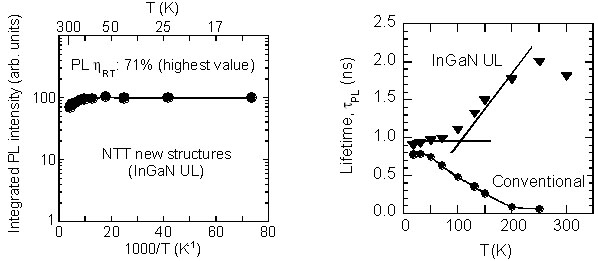Tetsuya Akasaka, Hideki Gotoh, Hidetoshi Nakano, and Toshiki
MakimotoMaterials Science Laboratory
InGaN quantum wells (QWs) have been widely used as the
active layers of light emitting diodes and laser diodes that emit light in
the visible-to-ultraviolet region. Nevertheless, the performance of these
devices has been limited, in part by the emission efficiency of InGaN QWs.
The emission efficiency of InGaN QWs is governed by various factors, such
as spatial fluctuation of the InN composition and nonradiative recombination
centers (NRCs). In this study, InGaN QWs were grown on InGaN under-lying layers
(ULs) which function to reduce the NRCs and spatial fluctuation of the InN
composition. These InGaN QWs on InGaN ULs have the highest luminescent efficiency
at room temperature (RT) ever reported [1, 2]. Time-resolved photoluminescence
(TRPL) revealed that adding indium atoms to the UL is effective in eliminating
the NRCs of InGaN QWs.
Figure 1 shows Arrhenius plots of integrated PL intensity for InGaN QWs on
an InGaN UL. The integrated PL intensity remains almost constant at 14-150
K and then falls gradually with a further increase of temperature. Even at
RT, however, it is 71 % of that at 14 K. This value is the highest ever reported
for the wavelength region of about 400 nm. PL lifetimes measured by TRPL,
τPL, are plotted as a function of temperature in Fig. 2. The τPL values
for a conventional InGaN QWs rapidly decrease with increasing temperature
because of the thermally activated NRCs. For the InGaN UL, τPL values stay
almost constant at 0.9 ns below 100 K, reflecting the behavior of localized
excitons. This means that the tail states originated from the fluctuation
of the InN composition is fairly shallow. From 100 to 250 K, τPL linearly
increases with temperature, which is characteristic of 2D-excitons in QWs.
This linear increase in τPL was clearly observed up to 250 K because of fewer
NRCs. These results indicate that the InGaN UL can effectively eliminate the
NRCs and also decrease the spatial fluctuation of the InN composition.
InGaN QWs on an InGaN UL are very promising for realizing novel optoelectronic
devices, such as polariton lasers and single photon emitters, which require
extremely high luminescent efficiency at RT.
[1] T. Akasaka et al., Appl. Phys. Lett. 85 (2004) 3089-3091.
[2] T. Akasaka et al., Appl. Phys. Lett. (accepted)
 |
|||||
|
|
||||